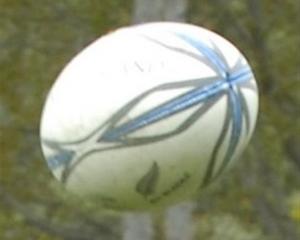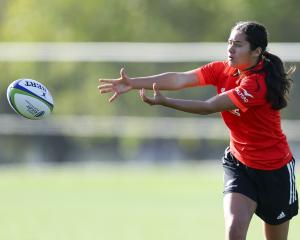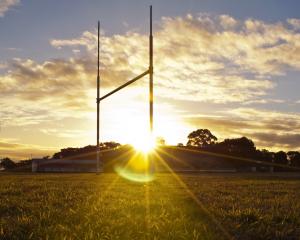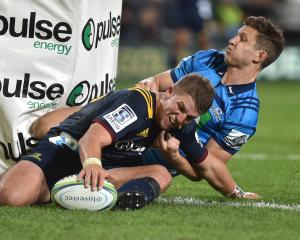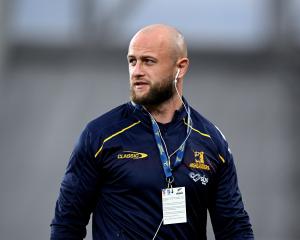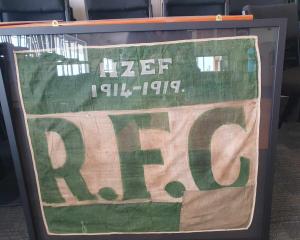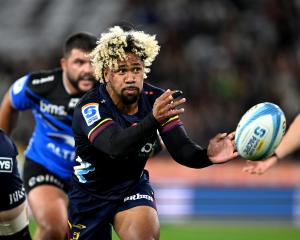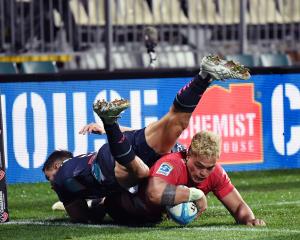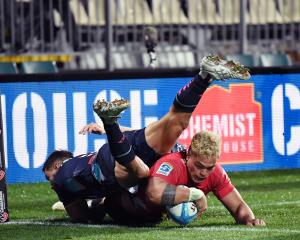After spending much of the domestic rugby season watching and analysing the Otago team, ODT Online rugby writer Jeff Cheshire delivers his verdict on what was good and what was not with the boys in blue.
The good
Not completely awful
There has been a lot of negativity flying around about this Otago team lately. Sure it was a disappointing season. They lacked a bit of punch and flair. But there were only four games in which you would say they were poor in and only two in which they were completely played off the park.
Against Northland and Hawkes Bay they were awful, albeit after short turnarounds. They were similarly bad against Bay of Plenty and Manawatu, although it was more inconsistencies and one-off mistakes which cost them these games.
Other than these they were reasonably good. Against North Harbour, Southland and Waikato they showed just how well they could play: urgency in their forward play, tenacious defence and some ingenuity on attack. Even in losses to strong Canterbury and Tasman teams they remained competitive and they came back to nearly rob Counties-Manukau. So do not just remember the poor finish to the season.
The best of the local players
It has been good over the past few years to see the Otago team made up of the best players in Otago, ones who were, in the coaches' opinions, the best players from the local club competition. This is in direct contrast to the unsuccessful model of a few years ago and the Tony Brown coaching regime deserves praise for this.
These are the players that we watch all year in club rugby. Surely it has to be satisfying and interesting to see these players who we know and can identify with playing against their equivalents in other provinces. The players who pull on the Otago jersey each year are the ones who have earned it, by playing well all season and showing that they are better than the other alternatives.
Sure there may be a few contentious decisions amongst these selections; is there ever not in sport?
In some ways we have to be realistic about Otago's financial position and perhaps, player availability. It was not that long ago that they were in dire straits financially and they do not have the money to go throwing at big names. Therefore they go after the best local players, which is the way it should be anyway. If these players are just not good enough at the next level, then so be it.
Young team
It was a young team this year and this is probably indicative of the increasingly young Premier Club competition. The very best talents these days go straight into the Premier grade out of school and many others will move on after one year of colts. Consequently, you have a younger player base to pick from and there are going to be more young players standing out. This is not necessarily a bad thing, as long as they all stick around. Unfortunately, that has been a problem, as many players come to Dunedin for University and then leave before Otago can really make use of their talents.
In this year's team there were few players who are truly established at provincial level. Liam Coltman, Tom Franklin, TJ Ioane, Lee Allan, Hayden Parker, Jayden Spence and Trent Renata have all been regulars for the past few years. Other than that, there were few others. Aki Seiuli only really came on as a prominent player at the end of last year, Charlie O'Connell has played bits and pieces, as has Sam Anderson-Heather and Peter Breen. Other than this you had a bunch of boys who were really seeing their first provincial action where they were being relied upon to be more than just development-type players.
The midfield of Tei Walden and Michael Collins exemplified this, both of whom had to take on much larger roles this season than they have in the past. Both halfbacks were in similar situations, as was winger Fa'asiu Fuatai. There was a lack of a second prop, without Craig Millar and Scott Manson available, while James Lentjes, Joe Latta and Jackson Hemopo all provided good performances despite being in their first year's in prominent roles. As long as everyone has learnt from this year, they will be better in the future, meaning something can be salvaged from a disappointing season.
Four good locks
It was difficult to pinpoint too many areas where Otago excelled this year. But one was certainly in the locking stocks. In Tom Franklin, Joe Latta, Jackson Hemopo and Josh Dickson they had four players who rarely did not have a good game. Franklin returned this year with a big reputation and lived up to it. He delivered some big performances, showing physicality, the ability to range and cover, as well as being the best of the lineout jumpers. Latta was used more often to complement him, a hard worker who threw himself around and never stopped in a manner similar to Brodie Retallick. Hemopo was used for impact off the bench, but was no worse than the starters, providing explosiveness with ball in hand and aggression on defence. Lastly, Dickson answered any question about his physicality, imposing himself well and looking very keen and energetic.
Should they stick around, Otago will have four very good locks on their hands in the coming years.
The not so good
Too much of the same in the backs
Individually the backs were tidy enough on attack. That is fine. The problem was they were all tidy and without anyone offering any sort of flair, punch or incisiveness. Early in the year they showed some nice set-moves which created some space, but these became non-existent after the first month. Without these, there was nothing else to create havoc.
It certainly was frustrating. The midfield combination of Tei Walden and Michael Collins was solid on attack. But neither was ever going to break a game open like a Malakai Fekitoa. It would have been more prudent to have one of the two, probably Walden as he was better defensively, and then pair him with someone who does bring X-factor.
The same could be said about the back three. Fa'asiu Fuatai had his moments, but for the most part he was not fast or strong enough to pose a genuine threat. Trent Renata never looked like opening up a defence, while Jayden Spence was wasted on the wing and looked far more likely to create something in the midfield, which is ironic as this was what was lacking in the midfield. Someone like a Julian Savea, Patrick Osborne or Nemani Nadolo would have made a huge difference.
Too much of the same in the forwards
The problem in the forwards was the same problem with the backs. They were all too alike. Again they were a bunch of hard workers who tried hard at what they did. But other than prop Aki Seiuli and impact player TJ Ioane, there was just no dynamic presence there, no one to offer any go-
forward to get the defence disorganised on the back foot. This would have made it easier for the backs to find gaps.
Charlie O'Connell has copped much of the criticism for this. Perhaps some of it is granted. But this is more a selection issue, than a player issue. He has never been your blockbusting runner, hard-hitting No. 8. He is not an Isitolo Make, Nasi Manu or Kieran Read. He is a player who will work hard for 80 minutes, a hard grafting journeyman. If you are going to pick him, then fine that is great. You just have to complement him with players who bring some sort of dynamic ability.
In this case, there was no one providing it, other than the outstanding Seiuli. The looseforwards were all solid, hard workers. At least one probably needed to have a bit more to his game. The ability to run strongly, to offload, to put in a big hit, all would have been hugely beneficial. It is hard to put these problems down to just one man. Again, you can only pick from what you have available and it was always going to be tough after losing Paul Grant and Gareth Evans; Otago's best in this area in recent years.
Set-piece struggles
The scrum and lineout were both once again inconsistent. After a good performance first-up, the scrum was pushed around too easily by bigger forward packs all season. It did not provide a solid platform and too much ball was turned over, or penalties conceded, from here. Of the props, only Donald Brighouse really got a pass mark as far as this was concerned; look at the size of him, you would not expect him to go backwards.
Similar problems could be found in the lineout, although there were times where it actually functioned quite well. The throwing was once again inconsistent. It seems a shame to keep banging on about it, as it is obviously not an easy skill. In today's game though, it is such an integral part of the hooker's role. Just as a goal-kicker has to make his kicks, or a prop has to scrum well, a hooker has to be able to throw the ball in straight and not too high.
There were times when they excelled in this area. Tom Franklin in particular was found at the back well in some games, usually after coming a step or two forward. Likewise they generally were pretty solid going to the middle, with Joe Latta, Jackson Hemopo, James Lentjes and Charlie O'Connell all being used as options. But there were times where they struggled too and often they were when they really needed to execute. Most memorably was the botched attempt in the Ranfurly Shield challenge against Counties-Manukau, where on their own line, Otago called the ball to the back, overthrew it, and were unable to recover. Instances such as these are costly and occurred far too frequently.
Missed tackles
It is pretty basic, but sometimes you can put a loss down simply to missing one-on-one tackles. The Highlanders had the same problem last season. They would defend well for a long period, but then fall off a tackle, allow a break, find themselves scrambling and end up conceding a try. It was not that they could not tackle, they would show that they could. It was the way they let up after having defended so well for a long stretch, effectively undoing all of the hard work.
There have been a few comments made regarding the defence of the midfield. It is true that there were some pretty soft tries let through that region. But that does not necessarily mean that it was the midfielders who were missing the tackles. Michael Collins had a few bad misses and at times was just too slow. But it would be hard to knock Tei Walden too much for his defensive effort. He tackles with good technique and goes looking for work, in one game making 18 tackles. All up this year he made 83 tackles and missed nine, for a total success rate of 90.2 percent. This puts him well above the team percentage of 82.8 and even well above of the most successful team's percentage of 85.3.
Mistakes
Along with too many missed tackles, there were too many mistakes. Dropped balls, aimless kicks, poor option taking, lack of ball retention and disorganization on the chase all contributed to Otago's problems.
Again it was a case of individuals being solid, perhaps only making one or two mistakes per game. The problem was that everyone was making one or two mistakes per game and those mistakes start to add up. If you cannot hold onto the ball, you cannot apply pressure and if you cannot apply pressure, you are going to struggle to score points; plain and simple.
Departed talent
It was always going to be hard replacing some of the players that left after last year: Gareth Evans, Paul Grant, Buxton Popoalii, Fumiaki Tanaka. All were players that did bring some X-factor and for varying reasons were not available to this year's selectors. However, there was talent that was available that they let slip through their fingers.
Brad Weber is the obvious one who would have made a huge difference. He is a halfback who can pass, run, kick and tackle. His running game is explosive and he presents enough of a threat from the base that he can create something and add some spark.
Likewise Liam Edwards headed north after being unable to crack the Otago team. He has been a standout player in both club rugby and the Heartland Championship in recent years and does have the ability to spark something, with a good step, good vision and as much speed as anyone in the Otago squad.
Halfback
Halfback was clearly an issue, as everyone knew it would be when it was announced Tanaka was not returning. In Josh Renton and Nick Ealey, Otago had two halfbacks who were probably more at the level of an average backup, who could come on and finish off a game to gain experience. Neither was at the level required to start. Renton has a crisp pass, but had a habit to step across the field before delivering it, while also looking weak on the tackle. He does not have a dynamic running game and has yet to show an intelligent kicking game either. There is potential for him to develop into a tidy player, but he does look as though he will be limited if he does not develop another string to his bow.
Ealey was the better of the two. He provided quicker ball and looked more threatening. However, he was still mistake prone and would make the occasional bad one which hurt the rest of his game. Neither really had the ability to take control of a game and provide the energy and direction needed.
Again, how handy would Brad Weber have been?
Statistically speaking
Rugby is a game that cannot be analysed purely by looking at statistics. They can make for some interesting reading though. In this case, they back up many of the issues Otago seemed to have this year. They scored the least tries of anyone in the competition, with just 23 in ten games. In clean breaks they also finished last, making just 71 and were a mile behind the majority of the other teams. The defenders beaten stat was not much better, ahead of only Wellington and one of only three teams to not get above 200. They had the sixth most carries of any teams, but finished twelfth in metres gained, suggesting they lacked any impact or go-forward. At ruck time they finished last equal in terms of securing their own ball. Really tells a story doesn't it?


